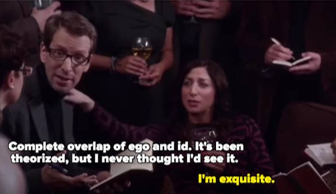The Psychoanalytic Perspective
1/71
There's no tags or description
Looks like no tags are added yet.
Name | Mastery | Learn | Test | Matching | Spaced |
|---|
No study sessions yet.
72 Terms
Lecture Roadmap
basic themes
Topographical model of the mind
Structural model of personality
Defense mechanisms
Accessing the unconscious
Neo-Freudian extensions
Evaluating Freud today
Learning Objectives
define and describe the parts of the topographical model (i.e. conscious, pre-conscious, unconscious)
Define and describe the parts of the structural model (i.e. id, ego, super-ego)
define the different defense mechanisms (e.g. denial, repression, projection… etc.) and be able to apply them to an example
define free association, parapraxes, and projective tests
define and explain manifest vs. latent content in a dream and be able to apply to an example
describe some of the key extensions of Freud’s work (especially Jung and the collective unconscious)
Explain which parts of Freud’s theory have modern empirical support, and which do not
Sigmund Freud
medical doctor working in vienna
specialized in “nervous disorders”
saw women who complained of “hysteria”
Known as the ‘father’ of personality psychology (even though many of his ideas are not supported today)
Basic Themes
Psychodynamic
Psychological defense
Psychic determinism
Psychodynamic
Personality shaped by dynamic “forces” - often unconscious - inside a person
These forces can sometimes conflict and work against each other
Psychological Defense
Freud had a rather dark view of human nature
Theory assumes that everyone experiences psychological threats that must be dealt with
Psychic determinism
Nothing happens by chance
Freud believed that everything a person does/says has a cause - no “accidents” or “innocent mistakes”
Topographical Model
configuration of the mind, organized into three layers of “consciousness” (awareness)
Topographical Model of the Mind - breakdown
conscious
preconscious
unconscious
topographical model - is it supported
NOT SUPPORTED
conscious
the part of the mind that holds what you are now aware of
Preconscious
the part of the mind that you can become easily aware of (e.g. ordinary memories)
Unconscious
the part of the mind you are not aware of and cannot become easily aware of. contains “darker” memories, urges, and desires
examples of each topographic model
Conscious mind – taking notes
Preconscious – ordinary memories – what you had for breakfast, what you did with friends
Unconscious – connects to psychological threat

topographic iceberg
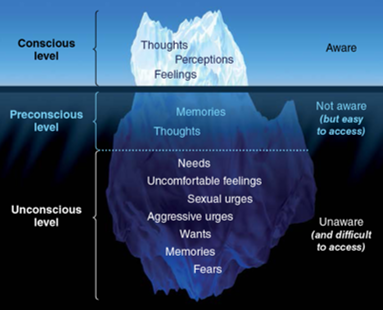
Implicit processes
automatic, unconscious, and fast ways of thinking that happen without awareness
Explicit memories – conscious memories
Importance of non-conscious processes - is it supported
generally supported
structural model of personality
idea that personality consists of three psychological aspects that interact to influence behaviors
id
ego
super-ego
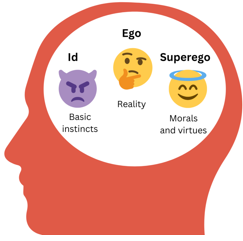
id
the inherited, instinctive, primitive aspects of personality
first to develop (present at birth)
pleasure principle - all needs should be satisfied immediately
“treat yourself day” – a day where they get whatever they want
Think about kids and delayed gratification- if they are at the store, they need that toy now. They want that cookie now instead of after dinner
ego
mostly conscious part of personality
develops from the id and harnesses part of the id’s energy for it’s own use
reality principle - takes reality into account in addition to wants and desires
tries to express id’s impulses effectively
engages in self-control and delayed gratification=
ego = you, (“I” or “yourself”)
ex. “ok, we can have the cookie but we need to eat dinner first” – delayed gratification
super-ego
the moral part of one’s personality
last part of personality to develop
develops through incorporating parental and societal values (thru processes called introjection)
morality principle - should always do what is morally right
ex. - Mom instilling value into you of making handwritten thank you notes every time you get a gift –that is introjection and that’s the super-ego
example of id, ego, superego
Ego = trying to satisfy both id and superego
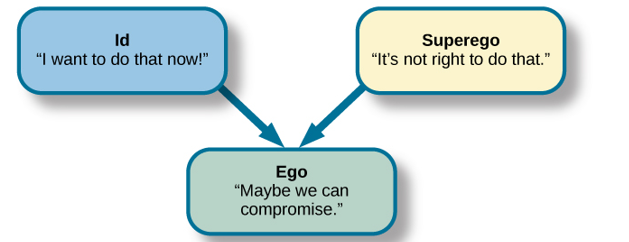
dexter example id, ego, superego

ego strength
ego’s ability to be effective despite conflicts and competing pressures
personality
a dynamic organization, inside the person, of psychophysical systems that create the person’s characteristic patterns of behavior, thoughts, and feelings.
updated iceberg - topographic and structural
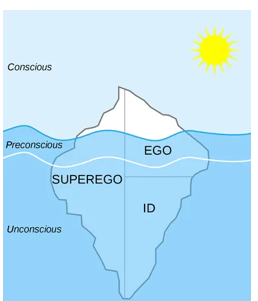
structural model (id, ego, superego) - is it supported
NOT SUPPORTED (not really testable anyway)
Need to be able to conduct a study that the id doesn’t exist – null hypothesis testing. This is hard bc it is unconscious
Defense Mechanism Types
Freud thought much of personality revolved around anxiety
3 types
reality anxiety
neurotic anxiety
moral anxiety
reality anxiety
a danger in the real world
Neurotic anxiety
fear of punishment for following id’s impulses
defense mechanisms
how we deal with all this anxiety
defense mechanisms: tactics that the ego develops to help avoid anxiety
distort reality in some way
operate mostly unconsciously
Kinds of defense mechanisms
Denial
Repression
Projection
Rationalization
Intellectualization
Reaction formation
Displacement
Sublimation
… and others!
Denial
ego reduces anxiety by refusing to believe that the source of the anxiety exists
Example 1: Your significant other breaks up with you, but you continue to believe & act as though you are still together
Example 2: You have an addiction that is getting out of hand, but insist everything is okay and you can stop any time you want to.
(shrek having crush on fiona but denies it)
Repression
ego reduces anxiety by putting anxiety-inducing thoughts outside of conscious awareness (person is not aware the ego is doing this)
Example 1: You were bitten by a dog as a child but repressed the memory. Now you have a phobia of dogs, but you don’t know why
Example 2: You forget to call someone -> you secretly harbor anxiety or anger to that person and your ego is trying to manage that.
(doctor who clip where the guy forgets about the billions of deaths caused)
Repressed memories
claim that memories for traumatic events may be stored in the unconscious mind and blocked from normal conscious recall
are repressed memories real? false memories and Elizabeth Loftus
memories are fallible and easily changed
Repressed Memories - is it supported
NOT SUPPORTED
Projection
ego reduces anxiety by taking uncomfortable impulses off the self and placing them onto others
Example 1: You harbor unconscious dislike for a coworker, so you decide that they are really the one who dislikes you.
Example 2: You are unfaithful to your partner, so you accuse them of cheating on you.
even if you don’t cheat yet, it is still projection
Reaction formation
ego reduces anxiety by prompting behaviors that are the opposite of the anxiety-inducing impulse
Example 1: Someone who is a staunch pacifist (i.e., opposed to war) may actually be trying to mask aggressive impulses (Thanatos drive)
Example 2: A legislator works really hard to pass a law outlawing an activity he/she is guilty of
Phobia example – Freud might say that unconsciously you actually really want what you “fear”
reminds me of guys not wanting insta models but that’s actually their type lol
(jealous girlfriend video example - extra nice instead of mean to ex)
Rationalization
reduce anxiety by finding a rational explanation (i.e., excuse) for some behavior or outcome
Example 1: a person might rationalize getting passed over for an important promotion by suggesting that they didn’t really want the job in the first place. (“sour grapes”)
Example 2: Someone who cheats on their taxes may argue that it reduces the amount of money spent on weapons in the world
Intellectualization
the tendency to think about threats in cold, analytical, and emotionally detached terms
example 1: After receiving a health diagnosis, person looks up a all the information/research and view through very “clinical” lens
example 2: A man who lost his wife may focus all of his energy on funeral arrangements and logistics instead of acknowledging his grief.
Displacement
moving a troubling impulse onto a different, less threatening object
Example 1: A tennis player angry at a bad ref call wrecks his racket
Example 2: You had a bad day at work, and when you come home instead of yelling at your boss (like you really want to) you yell at a family member instead - familiar lol
(beginning of footloose example video)
Sublimation
ego reduces anxiety from an unhealthy impulse by re-directing it into a more socially acceptable and constructive activity
a more healthy version of displacement
Example 1: You satisfy your unconscious aggressive impulses by channeling them into a professional sports career
Example 2: After a breakup, you channel your anger into working really hard on your schoolwork
Do you understand how this manages to satisfy both the desires of the id and the super-ego?
(end of footloose example video)
Defense Mechanisms
george valliant’s (1977) continuum
◦Actually some modern evidence that more “immature” (vs. mature) defense mechanisms are correlated with more maladaptive (vs. adaptive) coping techniques (Silverman & Aafjes-van Doorn (2023)

Defense mechanisms - is it supported
mixed evidence
How would you assess personality from a psychodynamic perspective
unconscious level
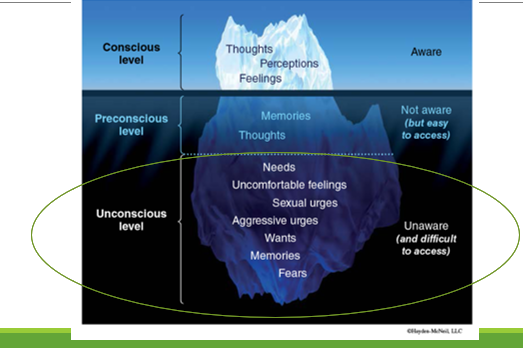
Parapraxes - assessing the unconscious
Freud believed nothing was accidental
parapraxes - “accidents” (e.g. memory lapses, slips of speech) that actually provide insight into a person’s true (unconscious) desires
ex. “freudian slip”
friends Ross marriage slip video
Free association
talking freely; saying whatever comes to mind
Psychoanalysis
a form of psychotherapy that focuses on exploring the unconscious mind and its influence on current thoughts, feelings, and behaviors
Psychoanalysis Therapy - is it supported
very mixed evidence
Wish fulfillment
Freud believed that unconscious desires could be revealed in dreams
wish fulfillment - freud thought that dreams represent unconscious desires, thoughts, and motivations that our conscious mind represses.
Manifest content
what actually happened in the dream
Latent content
unconscious desires “hidden” beneath the surface, the symbolism/meaning underlying the manifest content
examples
parents: can represent authority figures or unresolved childhood issues
siblings: can represent rivals or relationships with others
Dream analysis - is it supported
NOT SUPPORTED
Projective tests
A psychological test in which words, images, or situations are presented to a person and the responses analyzed for the unconscious expression of elements of personality that they reveal
ex. Rorschach inkblot test - psychologist/clinician infers unconscious fears and desires based patient’s interpretation of ambiguous inkblots
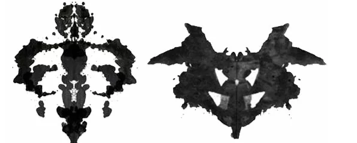
Projective tests and support
Psychometric properties of the inkblot (and other projective) tests:
is it reliable?
Not really… inter-rater reliability for many indices was pretty low
◦Not many good studies of test-retest reliability, and estimates range pretty widely (e.g., from .2 - .9)
is it valid?
probably not. Not good as a diagnostic tool (e.g., for diagnoses psychiatric disorders)
Also little correlation with self-report measures of personality
Projective tests - is it supported
NOT SUPPORTED
Psychosexual stages of development
Freud’s idea about how personality develops during childhood
Thought that children moved through various stages
Each stage associate with conflicts; if conflicts were not resolved correctly, could result in problems in adulthood
Psychosexual stages of development support
NOT SUPPORTED
Neo-Freudian Extensions
anna freud
carl jung
alfred adler
karen horney
Anna Freud
◦Sixth and youngest child of Sigmund Freud
◦Emphasized “normal” development of the ego
◦Worked to fully develop defense mechanisms
Carl Jung (important)
◦Swiss psychiatrist
◦Student of Freud until the two parted ways
collective unconscious
carl jung believed in this
shared, inborn set of memories and ideas specific to each species
Archetypes
shared, inborn set of memories and ideas specific to each species
◦Hero
◦Heroine
◦Wise old man
◦Trickster
◦Shadow
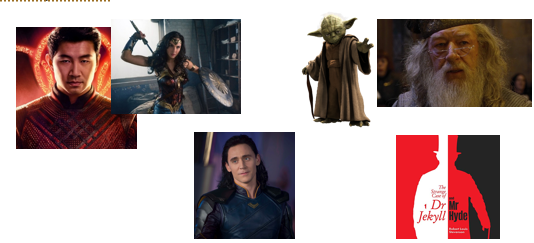
Ego attitudes and functions
ways people engage with and perceive the world
◦Extraversion vs. introversion
◦Thinking vs. feeling
◦Intuition vs. sensation
(Katherine Cook Briggs and Isabel Briggs Myers)
Alfred Adler
◦Early colleague of Freud’s
◦Focused more on drive for power
Inferiority complex
the belief that one is of lower status or weaker than others.
alfred adler belief
Compensation
is to react against perceived inferiority by asserting oneself
alfred adler belief
Karen Horney
Challenged male-centric view of Freud’s theory
Took a more social perspective – believed that neurosis/disorders arose from basic anxiety caused by interpersonal relationships
evaluating freud today
Remember, good scientific theories should be:
1. Make testable, falsifiable predictions
Freud’s theory is very hard to test and ideas hard to measure
Theory is too flexible (does not make “risky” predictions)
2. Supported by data
Freud’s ideas based on his subjective interpretation of a small handful of case studies. Not tested with empirical studies
3. Parsimonious - simple
Freud’s ideas very complex!!
Importance of past/childhood events support
generally supported
Freud Theories and if they are supported
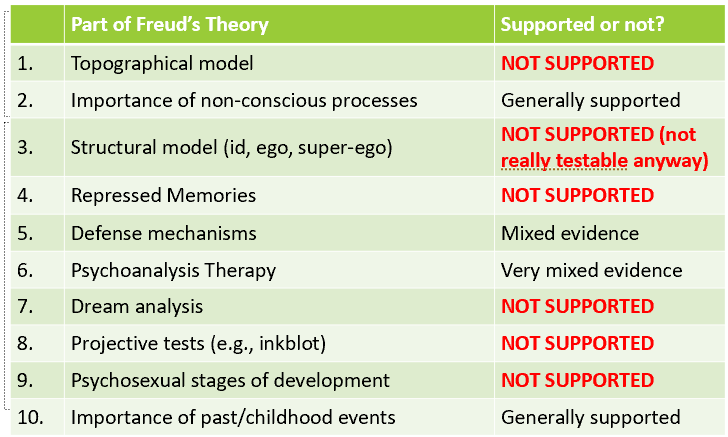
Why do we still teach freud
◦Very influential (inspired a lot of additional research and ideas… some still with us today even if not technically correct)
